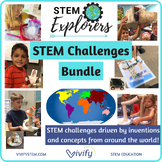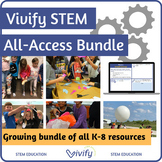Antarctica Shelter STEM Challenge - Engineering Design
- PDF
What educators are saying
Also included in
- STEM Explorers Bundle - Global Engineering ChallengesPack your bags and take your students on a voyage of STEM challenges that incorporate the engineering design process with themed activities from countries around the world. This STEM curriculum includes activities that travel to each continent andPrice $30.40Original Price $38.00Save $7.60
- GROWING bundle for Digital STEM challenges for Elementary! Perfect to support distance learning and hybrid classrooms. Lessons include: Complete Teacher Guide: Detailed teacher guide with links to resources, grading rubric, handouts on a STEM career connection and science background, and handouts foPrice $80.52Original Price $94.65Save $14.13
- Are you in need of year-round STEM activities? This growing bundle includes our most popular STEM lessons and engineering design challenges for elementary! Activities are adaptable for 1st through 5th grade with guidance provided in the teacher notes. Need help with a STEM Curriculum Map? Grab our FPrice $410.72Original Price $513.40Save $102.68
- Are you in need of year-round STEM activities? This growing bundle includes ALL Vivify K-12 STEM lessons from team challenges, engineering design, semester-long STEM units, research projects, and more! Purchase everything for 20% off individual products! Here is a sample of what is included: Stage 1Price $990.24Original Price $1237.80Save $247.56
Description
Take your students on a educational journey to Antarctica with this complete lesson! Read the letter from fictitious travel guides explaining weather conditions and the hazards of living in Antarctica. Students will learn about "insulation" and "freezing point" as they complete introductory activities using dry ice (optional) and simulating animal blubber! An icebreaker activity facilitates teamwork as students must "cross the ice" to travel across the classroom while only touching sheets of paper "ice". Using the engineering design process, student teams are then tasked with designing an insulating shelter to prevent ice from melting! Students also learn about the STEM careers of geoscience, marine biology, and satellite engineering to bring in a real-world STEM connection. Related math problems extend the learning fun!
As with many STEM activities that are student-driven, this challenge can be tailored to students of various skill levels and abilities.
Included in this product:
- Detailed teachers guide with links to resources
- Grading rubric for the engineering design process
- STEM Career Connections
- Icebreaker activity instructions
- Student handouts to guide them through the engineering design process
- Math extension problems
Required Materials for Challenge: Styrofoam cups, tape, foil, card stock/standard paper, wax paper, scissors, paper plates, craft sticks, cotton balls, plastic condiment containers, small liquid measurement containers, and ice.
Looking for more STEM lessons? Our team of engineers and educators is dedicated to developing low-prep and high-quality STEM activities for any classroom! Click below to learn more:
- Vivify's Scope & Sequence + Standards Alignment
- Vivify's Resource Guide
- Learn about the 3 Stages of STEM
- Vivify STEM Membership
Customer Tips:
• Click the Green ★ to follow our store and get notifications of new products and freebies
• Leave feedback to receive TpT credit for use on future purchases
• Questions? Contact us in the Product Q&A section
♥ Connect With Us ♥
Email us: info@vivifystem.com








